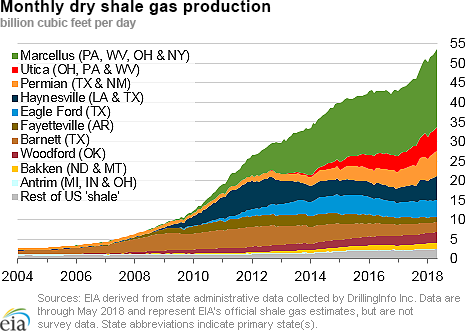In the News:
Natural gas supply and consumption grow significantly from the first half of 2017 to the first half of 2018
Natural gas supply and consumption have grown significantly from the first half of 2017 through the first half of 2018. According to data from PointLogic Energy, total natural gas consumption in the Lower 48 states averaged 87.4 billion cubic feet per day (Bcf/d) during the first half of 2018, which is 8.4 Bcf/d (11%) greater than during the first half of 2017. The total supply of natural gas averaged 84.8 Bcf/d during the first half of 2018, a 7.8 Bcf/d (10%) year-on-year change.
Natural gas consumption in the first half of 2018 grew in all sectors compared with the year-ago levels:
- The largest growth occurred in residential and commercial consumption, which rose by 3.7 Bcf/d (17%) compared to the first half of 2017. Residential and commercial consumption is primarily related to heating needs, and the beginning of 2018 experienced record, prolonged cold temperatures across much of the Lower 48 states. According to the National Oceanic and Atmospheric Administration, there were about 17% more population-weighted heating degree days (HDD) during the first half of 2018 than during the first half of 2017.
- The volume of natural gas used for electricity generation (power burn) during the first half of the year increased by 2.2 Bcf/d (9%) from 2017 to 2018. Power burn is also related to temperature, as hot weather increases electricity consumption for air conditioning. However, 2018’s higher power burn was not a result of hotter temperatures; the number of population-weighted cooling degree days (CDD) in the first half of 2018 was similar to the first half of 2017. Instead, the increased power burn may have resulted from the increased buildout of natural gas-fired power plants, continued coal-to-gas switching, and the use of electric heating during the cold weather.
- The first half of 2018 saw an increase in exports over year-ago levels. Liquefied natural gas (LNG) exports and net pipeline exports to Mexico collectively increased by an average of 1.4 Bcf/d (23%) from the first half of 2017 through the first half of 2018.
The increase in natural gas supply was driven by dry production, which rose 7.4 Bcf/d (10%) from the same period last year. Production increases were facilitated by the additional pipeline capacity brought into service since June 2017, including the Leach XPress, the Rover Pipeline, and Phase 1 of Atlantic Sunrise. Net pipeline imports from Canada increased slightly, likely related to the colder weather.
Overall, consumption increased 0.7 Bcf/d more than supply. This market tightening was reflected in the large storage withdrawals this year and the current low levels of natural gas in storage relative to the five-year average.
Overview:
(For the Week Ending Wednesday, June 27, 2018)
- Natural gas spot prices rose at most locations this report week (Wednesday, June 20 to Wednesday, June 27). The Henry Hub spot price rose from $2.95 per million British thermal units (MMBtu) last Wednesday to $3.00/MMBtu yesterday.
- At the New York Mercantile Exchange (Nymex), the July 2018 contract expired yesterday at $2.996/MMBtu. The August 2018 contract price increased to $2.981/MMBtu, up 2¢ Wednesday to Wednesday.
- Net injections to working gas totaled 66 billion cubic feet (Bcf) for the week ending June 22. Working natural gas stocks are 2,074 Bcf, which is 26% lower than the year-ago level and 19% lower than the five-year (2013–17) average for this week.
- The natural gas plant liquids composite price at Mont Belvieu, Texas, fell by 3¢, averaging $8.33/MMBtu for the week ending June 27. The price of propane and isobutane fell by 2% and 7%, respectively. The price of natural gasoline, ethane, and butane rose by 1%, 5%, and 2%, respectively.
- According to Baker Hughes, for the week ending Tuesday, June 19, the natural gas rig count decreased by 6 to 188. The number of oil-directed rigs fell by 1 to 862. The total rig count decreased by 7, and it now stands at 1,052.
Prices/Supply/Demand:
National benchmark spot price increases again this week. This report week (Wednesday, June 20 to Wednesday, June 27), the Henry Hub spot price rose 5¢ from $2.95/MMBtu last Wednesday to $3.00/MMBtu yesterday. Weather for the period was somewhat mixed, with temperatures along the southern border generally rising through the report week and temperatures in the Northeast and Midwest generally falling.
Spot price at a key Midwest trading hub increases. At the Chicago Citygate, prices increased 6¢ from $2.77/MMBtu last Wednesday to $2.83/MMBtu yesterday. Some analysts noted that expectations of hotter-than-normal weather in the coming days may be pushing prices up. The National Oceanic and Atmospheric Administration forecasts with relatively high certainty that temperatures in the near term will be higher than the seasonal norm in the next week or two, particularly in the Midwest and Northeast.
Southern California prices continue to be volatile with ongoing infrastructure constraints. Continuing the recent trend, spot prices in Southern California continued to experience large daily changes because of ongoing storage and pipeline limitations. Prices at PG&E Citygate in Northern California fell 8¢, down from $3.09/MMBtu last Wednesday to $3.01/MMBtu yesterday. The price at SoCal Citygate decreased 8¢ from $3.79/MMBtu last Wednesday to $3.71/MMBtu yesterday.
Northeast prices rise. At the Algonquin Citygate, which serves Boston-area consumers, prices went up 9¢ from $2.72/MMBtu last Wednesday to $2.81/MMBtu yesterday. At the Transcontinental Pipeline Zone 6 trading point for New York City, prices increased 22¢ from $2.80/MMBtu last Wednesday to $3.02/MMBtu yesterday. Prices in the region generally followed temperatures, increasing substantially yesterday.
Appalachian prices also went up, but more modestly. Tennessee Zone 4 Marcellus spot prices increased 2¢ from $2.19/MMBtu last Wednesday to $2.21/MMBtu yesterday. Prices at Dominion South in southwest Pennsylvania rose 1¢ from $2.31/MMBtu last Wednesday to $2.32/MMBtu yesterday.
Nymex futures rise. At the Nymex, the July 2018 contract expired yesterday at $2.996/MMBtu, up 3¢ from last Wednesday. The August 2018 contract increased to $2.981/MMBtu, up 2¢ from last Wednesday to yesterday. The price of the 12-month strip averaging August 2018 through July 2019 futures contracts climbed 1¢ to $2.924/MMBtu.
Average week-over-week supply increases slightly. According to data from PointLogic Energy, the average total supply of natural gas rose by 1% compared with the previous report week. Dry natural gas production grew by 1% compared with the previous report week. Average net imports from Canada decreased by 4% from last week.
Overall consumption rises slightly on increased residential and commercial demand. Total U.S. consumption of natural gas rose by 1% compared with the previous report week, according to data from PointLogic Energy. Natural gas consumed for power generation declined by 3% week over week. Industrial sector consumption increased by 1% week over week. In the residential and commercial sectors, consumption increased by 22%. Natural gas exports to Mexico decreased 3%.
U.S. LNG exports increase week over week. Six LNG vessels (combined LNG-carrying capacity 21.7 Bcf) departed the United States from June 21 through June 27 (all from the Sabine Pass liquefaction terminal). One tanker (LNG-carrying capacity 3.6 Bcf) was loading at Sabine Pass terminal on Wednesday.
Storage:
Net injections fall to lower than the five-year average. Net injections into storage totaled 66 Bcf for the week ending June 22, compared with the five-year (2013–17) average net injection of 72 Bcf and last year's net injections of 48 Bcf during the same week. Net injections averaged 9.6 Bcf/d and will have to average 13.3 Bcf/d for the remainder of the refill season to match the five-year average level (3,815 Bcf) by October 31. Working gas stocks totaled 2,074 Bcf, which is 501 Bcf lower than the five-year average and 735 Bcf lower than last year at this time.
EIA revises working gas levels for the previous report week. Revisions to working gas levels in the South Central region increased working gas levels by 4 Bcf for the week ending July 15, 2018. As a result of these revisions, the net change for the previous report week changed from 91 Bcf to 95 Bcf. The weekly net change for the week ending June 22 was not affected by the revision. EIA publishes revisions to the Weekly Natural Gas Storage Report (WNGSR), when reported changes to working gas levels are at least 4 Bcf at either a regional level or for the Lower 48 states. EIA last reported a revision for the week ending June 30, 2017.
Despite relatively low storage inventories, the average January 2019 futures contract price traded at a lower premium to the average spot price than last year at this time. During the most recent storage week, the average natural gas spot price at the Henry Hub averaged $2.96/MMBtu, and the Nymex futures price of natural gas for delivery in January 2019 averaged $3.18/MMBtu, 22¢/MMBtu higher than the spot price. A year ago, the January contract was 40¢/MMBtu higher than the spot price.
Reported net injections into storage are lower than the median of the range of analysts’ expections. According to The Desk survey of natural gas analysts, estimates of the weekly net change from working natural gas storage ranged from net injections of 58 Bcf to 77 Bcf, with a median estimate of 71 Bcf. At the 10:30 a.m. release of the WNGSR, the price of the Nymex futures contract for July delivery at the Henry Hub fell 2¢/MMBtu to $2.99/MMBtu with 798 trades executed. Prices recovered somewhat in subsequent trading, climbing to $3.01/MMBtu within two minutes of the release.
Temperatures are in the higher-than-normal range for the storage week. Temperatures in the Lower 48 states averaged 75 degrees Fahrenheit (°F), 4°F higher than normal and the same as last year at this time. Temperatures were 3°F higher than the level reported for the previous week.
See also:
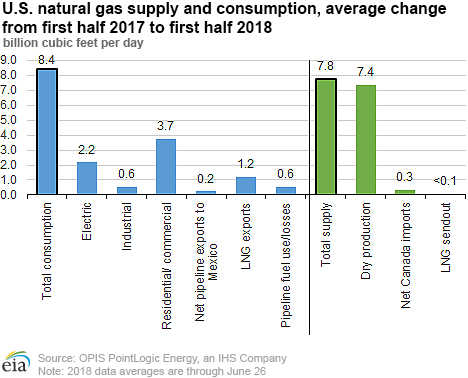
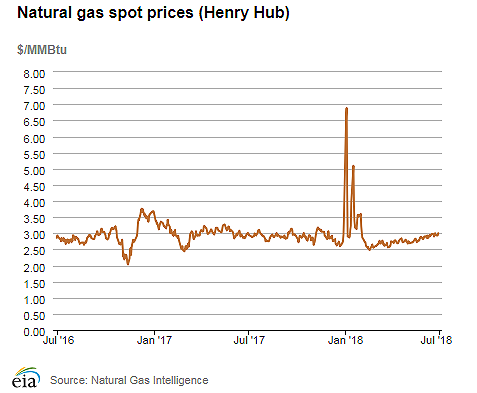
| Spot Prices ($/MMBtu) | Thu, 21-Jun |
Fri, 22-Jun |
Mon, 25-Jun |
Tue, 26-Jun |
Wed, 27-Jun |
|---|---|---|---|---|---|
| Henry Hub |
3.00 |
2.94 |
2.93 |
2.93 |
3.00 |
| New York |
2.61 |
2.69 |
2.73 |
2.73 |
3.02 |
| Chicago |
2.80 |
2.71 |
2.72 |
2.75 |
2.83 |
| Cal. Comp. Avg.* |
2.66 |
2.38 |
2.38 |
2.52 |
2.45 |
| Futures ($/MMBtu) | |||||
| July contract | 2.975 |
2.945 |
2.923 |
2.939 |
2.996 |
| August contract |
2.972 |
2.945 |
2.921 |
2.931 |
2.981 |
| *Avg. of NGI's reported prices for: Malin, PG&E Citygate, and Southern California Border Avg. | |||||
| Source: NGI's Daily Gas Price Index | |||||
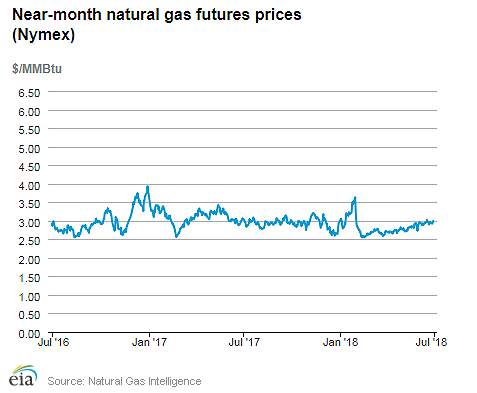
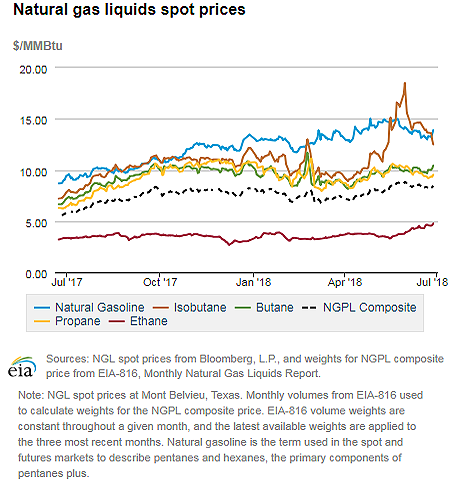
| U.S. natural gas supply - Gas Week: (6/21/18 - 6/27/18) | |||
|---|---|---|---|
Average daily values (Bcf/d): |
|||
this week |
last week |
last year |
|
| Marketed production | 91.2 |
90.2 |
80.4 |
| Dry production | 80.9 |
80.1 |
71.3 |
| Net Canada imports | 5.8 |
6.0 |
5.7 |
| LNG pipeline deliveries | 0.1 |
0.1 |
0.1 |
| Total supply | 86.7 |
86.1 |
77.0 |
|
Source: OPIS PointLogic Energy, an IHS Company | |||
| U.S. natural gas consumption - Gas Week: (6/21/18 - 6/27/18) | |||
|---|---|---|---|
Average daily values (Bcf/d): |
|||
this week |
last week |
last year |
|
| U.S. consumption | 60.5 |
59.8 |
56.8 |
| Power | 32.2 |
33.2 |
30.0 |
| Industrial | 19.6 |
19.4 |
19.6 |
| Residential/commercial | 8.8 |
7.2 |
7.2 |
| Mexico exports | 4.3 |
4.4 |
4.7 |
| Pipeline fuel use/losses | 6.7 |
6.6 |
6.3 |
| LNG pipeline receipts | 3.6 |
3.3 |
1.6 |
| Total demand | 75.1 |
74.2 |
69.4 |
|
Source: OPIS PointLogic Energy, an IHS Company | |||
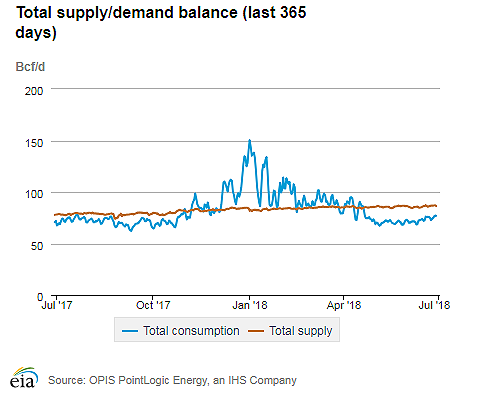
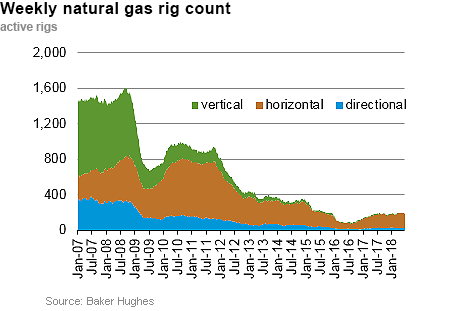
| Rigs | |||
|---|---|---|---|
Tue, June 19, 2018 |
Change from |
||
last week |
last year |
||
| Oil rigs | 862 |
-0.1% |
13.7% |
| Natural gas rigs | 188 |
-3.1% |
2.7% |
| Note: Excludes any miscellaneous rigs | |||
| Rig numbers by type | |||
|---|---|---|---|
Tue, June 19, 2018 |
Change from |
||
last week |
last year |
||
| Vertical | 60 |
0.0% |
-22.1% |
| Horizontal | 930 |
-0.2% |
17.4% |
| Directional | 62 |
-7.5% |
-13.9% |
| Source: Baker Hughes Inc. | |||
| Working gas in underground storage | ||||
|---|---|---|---|---|
Stocks billion cubic feet (Bcf) |
||||
| Region | 2018-06-22 |
2018-06-15 |
change |
|
| East | 430 |
406 |
24 |
|
| Midwest | 425 |
401 |
24 |
|
| Mountain | 133 |
127 |
6 |
|
| Pacific | 251 |
246 |
5 |
|
| South Central | 835 |
828 R |
7 |
|
| Total | 2,074 |
2,008 R |
66 |
|
|
Source: U.S. Energy Information Administration R=Revised. | ||||
| Working gas in underground storage | |||||
|---|---|---|---|---|---|
Historical comparisons |
|||||
Year ago (6/22/17) |
5-year average (2013-2017) |
||||
| Region | Stocks (Bcf) |
% change |
Stocks (Bcf) |
% change |
|
| East | 533 |
-19.3 |
543 |
-20.8 |
|
| Midwest | 673 |
-36.8 |
586 |
-27.5 |
|
| Mountain | 184 |
-27.7 |
159 |
-16.4 |
|
| Pacific | 280 |
-10.4 |
299 |
-16.1 |
|
| South Central | 1,140 |
-26.8 |
988 |
-15.5 |
|
| Total | 2,809 |
-26.2 |
2,575 |
-19.5 |
|
| Source: U.S. Energy Information Administration | |||||
| Temperature – heating & cooling degree days (week ending Jun 21) | ||||||||
|---|---|---|---|---|---|---|---|---|
HDD deviation from: |
CDD deviation from: |
|||||||
| Region | HDD Current |
normal |
last year |
CDD Current |
normal |
last year |
||
| New England | 6 |
-4 |
-1 |
25 |
9 |
-6 |
||
| Middle Atlantic | 1 |
-4 |
1 |
49 |
19 |
0 |
||
| E N Central | 2 |
-6 |
-1 |
70 |
33 |
15 |
||
| W N Central | 1 |
-7 |
-3 |
82 |
34 |
26 |
||
| South Atlantic | 0 |
-1 |
0 |
103 |
25 |
11 |
||
| E S Central | 0 |
0 |
0 |
102 |
29 |
22 |
||
| W S Central | 0 |
0 |
0 |
117 |
12 |
-4 |
||
| Mountain | 7 |
-12 |
4 |
56 |
-1 |
-29 |
||
| Pacific | 6 |
-7 |
2 |
20 |
-4 |
-45 |
||
| United States | 3 |
-5 |
0 |
70 |
18 |
-2 |
||
|
Note: HDD = heating degree day; CDD = cooling degree day Source: National Oceanic and Atmospheric Administration | ||||||||
Average temperature (°F)
7-Day Mean ending Jun 21, 2018
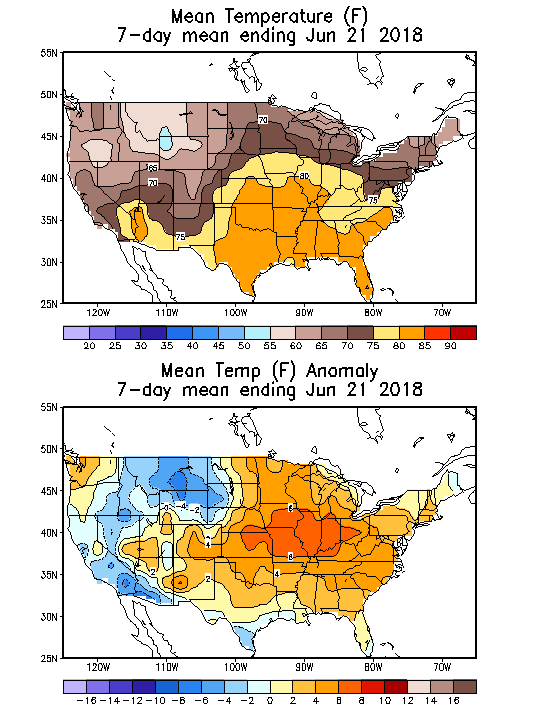
Source: NOAA National Weather Service
Deviation between average and normal (°F)
7-Day Mean ending Jun 21, 2018

Source: NOAA National Weather Service

